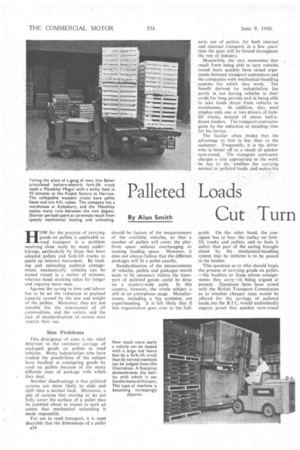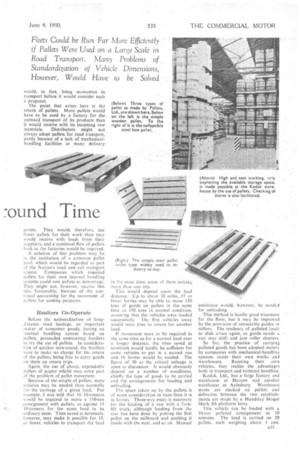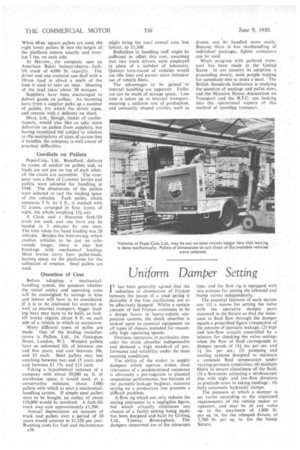Palleted Loads
Page 48

Page 49

Page 50

If you've noticed an error in this article please click here to report it so we can fix it.
By Alan Smith Cut Turn
round Time
HOW far the practice of carrying goods on pallets is applicable to road • transport is a problem receiving close study by many undertakingS,. particularly by those that have adopted pallets and fork-lift trucks to speed up internal movement. By loading and unloading palleted consignments mechanically. vehicles can be turned round in a matter of minutes, whereas hand stacking takes far longer
and requires more men. • Against the saving in time and labour has to be set the reduction in payload capacity caused by the size and weight of the pallets. Moreover, they are not suitable for the conveyance of all commodities, and the variety and the lack of standardization of carton sizes restrict their use.
Size Problems
rhis divergence of sizes is the chief deterrent to the extensive carriage of packaged goods on pallets in road vehicles. Many industrialists who have studied the possibilities of the subject have baulked at consigning goods by road on pallets because of the many different sizes of package with which they deal.
Another disadvantage is that palleted cartons are more likely to slide and shift than a normal load. Moreover, a pile of cartons that overlap or do not fully cover the surface of a pallet may be jumbled about in transit to such an extent. that mechanical unloading is made impossible.
For use in road transport, it is most desirable that the dimensions of a pallet a34 should be factors of the measurements of the available vehicles, so that a number of pallets will cover the platform space without overhanging or wasting loading space. However, it does not always follow that the different packages will fit a pallet exactly.
Standardization of the measurements of vehicles, pallets and packages would seem to be necessary before the transport of palleted goods could be done on a country-wide scale. In this country, however, the whole subject is still in an amorphous stage. Manufacturers, including a big combine, are experimenting. It is felt likely that if this organization goes over to the full
scale use of pallets, for both internal and external transport, in a few years' time the pace wilt be forced throughout the rest of industry.
Meanwhile, the very economies that result from being able to turn vehicles round more quickly have raised arguments between transport contractors and the companies with mechanics [-hand ling • systerhs for which they work. The benefit derived by industrialists lies partly in not having vehicles in their • yards for long periods and in being able' to take loads direct from vehicles to warehouses. In addition, they need employ only one or two drivers of forklift trucks, instead of about half-adozen loaders. The transport contractor gains by the reduction in standing time for his lorries. .
The haulier often thinks that the advantage to him is less than to the customer. Frequently, it is the driver who is better off as a result of quicker turn-round. The transport contractor charges a rate appropriate to the work ••. he has . to do, whether for carrying normal or palleted loads, and makes his • profit. On the other hand, the consignee has to bear the outlay on forklift trucks and pallets, and so feels it unfair that part of the saving brought about by the mechanical-handling system that he initiates is to be passed to the haulier.
This question as to who should begin the process of carrying goods on pallets .—the hauliers or those whose consignments they carry—is being argued at present. Questions have been raised with the British Transport Commission as to whether cheaper rates would be offered for the carriage of palleted loads, but the B.T.C. would undoubtedly reqUire proof that quicker turn-round would, in fact, bring economies in transport before it would consider such a proposal.
The point that arises here is the return of pallets. More pallets would have to be used by a factory for the outward transport of its products than it would receive with its incoming raw materials. Distributors might not always adopt pallets for road transport, partly because of a lack of media-Mealhandling facilities at many delivery
points. They would, therefore, use fewer pallets for their work than they would receive with loads from their suppliers, and a continual flow of pallets back to the factories would be required.
A solution of this problem may lie in the institution of a common pallet pool, which would be regarded as part of the Nation's road and rail transport system. Companies which required pallets for their own internal handling. systems could rent pallets as demurrage. They might not, however, receive this idea favourably, because of the continual accounting for the movement of pallets for costing purpoks.
Hauliers Co-Operate
Before the nationalization of longSstance road haulage, an important maker of consumer goods, having an internal . handling system based on pallets, persuaded contracting hauliers to try the use of pallets. In consideration of quicker turn-round, the hauliers were to make no charge for the return of the pallets, being free to carry goods on them on •return trips.
Again, the use of cheap. expendable pallets of papier mfIche may solve part of the problem of pallet movement.
Because of the weight of pallets, more vehicles_ may be needed than normally for the carriage of a given load. For example. 1 was told that 16 10-tonners would be required to move a 150-ton consignment with pallets, as against 15 JO-canners for the same load in its ordinary state. Time saved at terminals. however, may make it possible for 15, or fewer, vehicle to transport the load in the same time. some of them making more than one trip.
This would depend upon the lead distance. Up to about 30 miles, 15 or fewer lorries may be able to move 150 tons of goods on pallets in the same time as 150 tons in normal condition, assuming that the vehicles were loaded successively. The first vehicles .away would have time to return for another load.
. If movement were to be required in the same time as for a normal load over a longer .distance, the time saved at terminals would hardly be sufficient for some vehicles to put in a second run and 16 lorries would be needed. The figure of 30 as the critical mileage is open to discussion. It would obviously depend on a number. of conditions, chiefly the type of goods to be carried and the arrangements for loading and unloading.
The space taken up by the pallets_is of more consideration in vans than it is in lorries. Three-way entry is necessary for the loading of a van with a fork.lift truck, although loading from the rear has been done by putting the first pallet on the tailboard and pushing it inside with the next, and so on. Manual assistance would, however, be needed
for unloading. .
This method is hardly good treatment for the floor, but it may be improved by the provision of retractable guides or rollers. The tendency of palleted loads to slide arises again, as goods inside it van may shiftand jam roller shutters So far, the Practice of carrying paneled goods has been adopted mainly by companies with mechanical-handling systems inside their own works and warehouses. Running their own vehicles, they realize the .advantages both in transport and terminal handling.
Kodak, Ltd., has a large factory and warehouse at Harrow and another warehouse at Aylesbury. Warehouse stores are stacked on pallets and deliveries between the two establishments are made by aMandslay.Mogul Mark Ill platform lorry.
This vehicle can be loaded with a 10-ton palleted consignment in .10 minutes, The load is carried • on 29 Pallets, each weighing about 1 cwt. When 48-in, square pallets are used, the eight lower pallets fit into the length Of the platform almost exactly and over
lap 3 ins, on each side.
At Harrow, the company uses an American Baker battery-electric fork,• lift truck of 4,000 lb'. capacity. The driver and one assistant can-deal with a 10-ton load in .abouta tenth of the time it tikedto take six men. Sheeting of the load take'sabout 20 minntes.
Suppliers have been encouraged to deliver goods on pallets. An incoming lorry from a supplier picks up a number of pallets, for which the driver signs, . and returns With a delivery on them.
Mars; Ltd., Slough, maker of confec7 tionery, would also like ,to take more
deliveries on pallets from suppliers, but having exarnined•the subject: in relation to the-multiplicity of sizes of carton that it handles, the company is well aware of practical difficulties.
Cordials on Pallets
Pepsi-Cola, Ltd., Brentford, delivers its crates of Cordial on pallets and, as loads are not put on top of each other, all the crates areaccessible. The company uses a fleet of Commer lorries and pallets were adopted for handling in 1948. The dimensions of the pallets were selected to suit the loading space of the vehicles. Each pallet, which measures 3 ft. by '4 ft., is stacked with 32 crates, arranged. in four layers of eight, the whole weighing 13+ cwt: A Clark and a Stacatruc fork-lift ,truck are used, and one lorry can be loaded in 5 . minutes by one man. The time taken for hand loading was 20 minutes. Besides the time-saving, which enables vehicles to be out on sales rounds longer, there is also less breakage with mechanical loading. Most lorries carry four pallet-loads, leaving space on the platforms for the collection of empties. Steel pallets are used.
Question of Cost .
Before adopting a mechanicalhandling system, the question whether the initial outlay and operating costs will be outweighed by savings in time and labour will have to be considered, If it is to be instituted for external as well as internal transport, bigger loading bays may have to be built, as forklift trucks require about 8 ft. on each side of a vehicle in which to manceuvre.
Many different types of pallet are made. One of the leading manufacturers is Pallets, Ltd., 14, Ossington Street, London, W.2. Wooden pallets have an estimated life of between one and five years, and cost -between 10s. and £5 each. Steel pallets may last anything between two and 15 years and cost between £1 15s. and £15 each.
Taking a hypothetical instance of a company with about 50,000 sq. ft. of warehouse space, it would need, at a conservative estimate, about 5,000 pallets with which to start a mechanicalhandling systeni. If simple steel pallets were to be bought, an outlay of about £10,000 would be involved. A fork-lift truck may cost approximately £1,200.
Annual depreciation on account of truck and pallets over a period of 10 years would amount to £1,120 per year. Running costs for fuel and maintenance A36
might. bring the total annual cost, less labour, to £1,500.
Reduction in handling staff might be sufficient to offset this cost, assuming that two truck drivers were employed in place of a nul-nbei of labourers. Quicker turn-round -of vehicles would cut idle time and permit more intensive
use of vehicle fleets. ,
The advantages' .to be -gained' in internal handling are apparent. Fuller use.can be made of storage space. Less time is taken up in internal transport, ensuring ;.a uniform rate of production, and unusually shaped articles, such as
drums, can be handled more easily. Because there is less manhandling of individual packages, lighter containers can be used.
Much progress with palleted transport has been made in the United States. In our country its adoption is proceeding slowly, most people waiting for somebody else to make a start. The British Standards Institution is studying the-question-of package and pallet sizes, and the Mansion House Association on Transport and the B.T.C. are looking into -the operational aspec:s of this method of speediog transport.
















































































